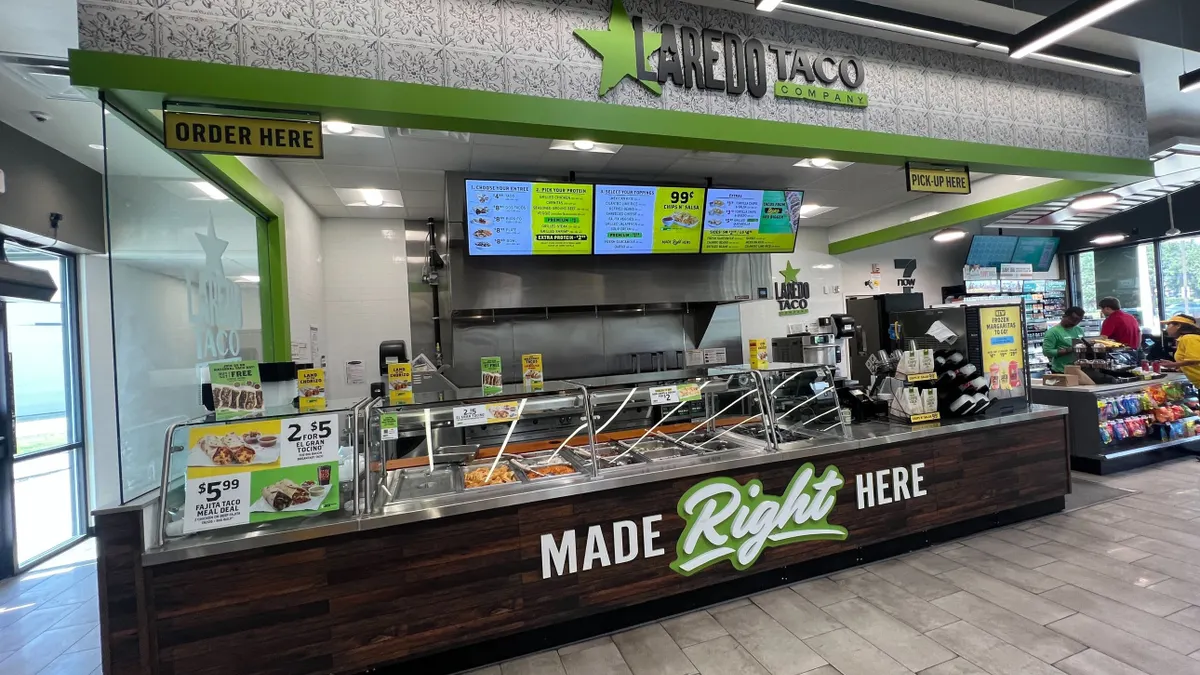In 1973, a Chinese immigrant and his son opened a little restaurant in Pasadena called the Panda Inn, serving authentic Chinese fare inspired by their hometown of Yangzhou — the Cantonese birthplace of fried rice. Restaurateurs Ming-Tsai and Andrew Cherng offered beef and Mu Shu, barbeque, Szechuan and sweet-and-sour pork at the establishment for a decade before creating Panda Express in 1983 to make Chinese cuisine more accessible to American consumers.
The family-run chain expanded slowly, opening its 100th restaurant in 1993 before bursting tenfold by 2007. Today, Panda operates more than 2,100 restaurants predominantly in the U.S., though the chain has entered Canada, Mexico, Guam, Puerto Rico, South Korea and the United Arab Emirates with its quintessentially Chinese-American quick-service foods.
Since its launch, the company has never strayed from its roots in Chinese-American cooking — including its iconic orange chicken, which was first created in 1987 — and now perfects new dishes in an "innovation kitchen" at its Pasadena headquarters. Restaurant Dive spoke with culinary director Jimmy Wang about where Panda Express started, how it's changed and where he sees its menu fitting into the future of combo cuisines and quick-service.
Questions and answers have been edited for clarity and brevity.
RESTAURANT DIVE: Do consumers crave more authentic Chinese food from Panda these days, or do you see a promising future in the truly Chinese-American combo?
Wang: American Chinese cuisine is very authentic to Panda Express. Our ever-evolving style of food was born from adapting traditional Chinese recipes, flavors and cooking techniques to American ingredients and tastes. As American palates evolve, we will continue to take inspiration from the local flavor profiles of both Chinese provinces and American regions.
Do consumers today have a better understanding of the differences between Asian cuisines? Has that affected your menu and dining experience?
Wang: Americans definitely have a more sophisticated understanding of the differences today than ever before, including the many different regional cuisines in China alone. We saw a unique opportunity here for Panda Express to be the gateway for guests to explore the complexities of Chinese cuisine — with an American twist. Our chefs have been focused on bringing these flavors and stories to the forefront over the past several years. Our focus is paying homage to [the company's] heritage and developing American-Chinese cuisine in a way that distinguishes us from our competitors.
"... a good way to build familiarity in terms of flavor is by presenting exotic flavor profiles first as condiments or add-ons to dishes."

Jimmy Wang
Culinary director, Panda Express
Have other regions influenced Panda creations over the years?
Wang: In our restaurants abroad, local cuisine plays an important role in our regional dishes, such as the grilled salmon with a miso-sesame sauce we serve in Japan. We're always exploring flavors and ingredients to incorporate into new dishes. We've been testing our Sichuan hot chicken dish in several markets, which was inspired by a trip to Chengdu, where Panda's chefs marveled at the variety of spices available, especially the Sichuan peppercorns. Most recently, we launched in Russia and announced our plans [to expand to] the Philippines.
In expanding to other states and regions with less influence from Asian cultures, has your approach to the food changed?
Wang: [In the U.S.] we offer regional dishes unique to specific communities. In Springfield, Missouri, for example, residents have enjoyed Springfield Cashew Chicken, which was created for and inspired by the guests who live there. We've also found that a good way to build familiarity in terms of flavor is by presenting exotic flavor profiles first as condiments or add-ons to dishes. By having Sriracha available as a condiment, we were able to successfully introduce Sriracha shrimp as a limited-time offering in markets that crave spice, such as New York. Although the LTO is not currently available, fans can recreate the popular dish by adding Sriracha to our honey walnut shrimp.
You opened an "innovation kitchen" in 2014. Why did you go that route and what are your goals with the program?
Wang: The goal of the Innovation Kitchen is to experiment with new flavors and dishes to ensure we're constantly creating fresh ideas. Each quarter we provide new offerings to our guests and sometimes use the Innovation Kitchen to test these dishes first. In the process of creating our newest dishes, we start with the foods that we enjoy and incorporate flavors that we know our American audience loves. We introduced a pork belly dish to our Innovation Kitchen menu, inspired by Americans' love of bacon, and that was something that resonated with our fans. We've also tested vegetarian dishes like a brussels sprouts and cauliflower entree in response to our audience craving a meatless option. This restaurant in particular is an important tool that serves to create a dialogue between us and our guests.
You also offer WokSmart, your health/calorie-conscious line. How has that menu changed since its 2009 launch, especially given more recent consumer demand for such choices in convenient packages?
Wang: Panda Express' vision for American-Chinese food is to offer a variety of flavorful options that speak to our guests. Our menus offer fan-favorites such as orange chicken while also incorporating health-forward choices like grilled teriyaki chicken and broccoli beef from our WokSmart menu — two of the most popular dishes on our whole menu. Our goal is to offer something delicious for everyone's tastes and to create endless possibilities on one plate — whether you are craving something indulgent, a better-for-you option, or both. The WokSmart menu actually comprises almost half of our entrees, including some of our favorite dishes like kung pao chicken and black pepper chicken.
"Our goal is to offer something delicious for everyone's tastes and to create endless possibilities on one plate — whether you are craving something indulgent, a better-for-you option, or both."

Jimmy Wang
Culinary director, Panda Express
In an NPR story about the 30th anniversary of your orange chicken, co-founder Andrew Cherng said, "People like the dessert before dinner or during dinner." Have you noticed changes in Americans' desire for sweet and fried?
Wang: As our guest preferences evolve, Panda Express continues to evolve with them. We have certainly seen our guests look for options that are more health-forward in recent years. [Our WokSmart menu] consists of items under 300 calories per serving and have at least 8 grams of protein per dish. At the same time, we continue to see our guests craving the sweet and savory dishes, which is the authentic flavor profile of the Yangzhou region where our co-founder Andrew Cherng is from. This year's limited-time offering, honey sesame chicken breast, was brought back for the fourth year due to popular demand. It's all about balance and offering a variety of options.
Competitors boast about their use of white meat, but your famous orange chicken uses dark meat. Have customers trended toward white meat in your restaurants?
Wang: In authentic Chinese cuisine, dark meat chicken is often preferred over white meat for its depth in natural flavor, texture, juiciness and ability to take on flavor of the marinades. All of these factors play an important part in creating our original orange chicken and why it continues to be our best-selling dish and fan-favorite. That being said, we strive to offer an array of menu items for different preferences, including using white meat chicken for all of our limited-time offerings and core menu entrée string bean chicken breast.
How has consumer demand for transparency affected your proprietary recipes and your ability to compete?
Wang: One of the best aspects about American-Chinese food is the ability to merge parts of the past and flavors that are familiar and bring them forward in original ways. Providing a selection of delicious entrées from our WokSmart menu and our continuous creation of health-forward options is a way that our restaurant stays competitive and truly evolves with our audience.
How about in your international markets?
Wang: We are fortunate that our success over the last 35 years has given us the tools necessary to bring American-Chinese food into international markets. As we further shape perceptions of American-Chinese food, we will always be inspired by and listen to what our guests have to say, in order to keep creating dishes with [that] duality in mind.
Does Panda see itself as the standard-bearer for how independent Chinese-American restaurants inserted themselves in American culture, from city to suburb and everywhere in between?
Wang: When Panda Inn was established, pandas were viewed as a symbol of friendship between China and America. Our co-founders Andrew and Peggy Cherng are Chinese immigrants themselves. As our company has grown, we will always be proud ambassadors of American-Chinese culture and cuisine.
















